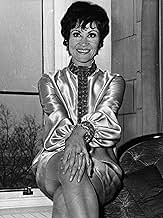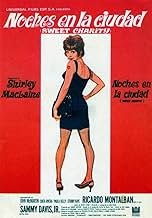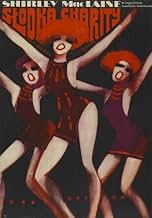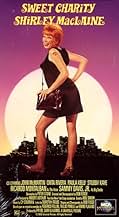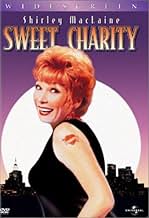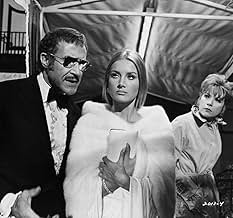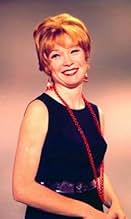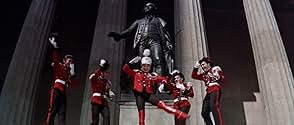AVALIAÇÃO DA IMDb
6,9/10
7,3 mil
SUA AVALIAÇÃO
Adicionar um enredo no seu idiomaA luckless taxi dancer in New York City seeks a better life and finds love along the way.A luckless taxi dancer in New York City seeks a better life and finds love along the way.A luckless taxi dancer in New York City seeks a better life and finds love along the way.
- Direção
- Roteiristas
- Artistas
- Indicado a 3 Oscars
- 6 indicações no total
Dante DiPaolo
- Charlie
- (as Dante D'Paulo)
Leon Alton
- Dancer
- (não creditado)
Avaliações em destaque
Great Sets, choreography, music, cast. "If They Could See Me Now" is worth the price of admission. "I'm A Brass Band" is also a highlight. Somewhat depressing story line makes this a happy/unhappy experience. But if you haven't seen it, give it a whirl. I hear the DVD has an alternate ending, which may be a good idea!
This is loaded to the brim with that dancing and just general idiosyncratic "cool" feeling that made Fosse who he was as a creator. "Big Spender" and "If My Friends Could See Me Now" are all-timer Musical numbers in film history. And yeah, a couple of the numbers have certainly dated (hearing Sammy Davis tell a bunch of Broadway Hippies to "Sock it to me" in the "Rhythm of Life" number is worth a major eye-roll), plus Fosse's attempts to do uh La Jetee type still image montages at a couple of points. However, Shirley MacLaine is often so moving in a role that others might have played a little less intensely felt (what sold me was the job interview scene, which is just about perfect, but her comic timing is impecable). She's adorable but also very serious as a person, which is hard to pull off.
It's big and flashy and a little bit silly (I like to call Ricardo Montalban Casanova Khan in this), and the director jumps off from Fellini and Neil Simon (in a Peter Stone script) for as much audacious advantage as he can. Not all of it works, but it's far from a "disaster" like Pauline Kael called it. 7.5/10
Bob Fosse's first opportunity to direct a movie was the 1969 film version of his own Broadway musical SWEET CHARITY, a musical based on the film NIGHTS OF CABERIA, with a book by Neil Simon and music by Cy Coleman and Doothy Fields. The story is best described by the film's subtitle: "The Adventures of a Girl Who Wants to be Loved". Shirley MacLaine, taking over the title role from Fosse's wife and muse, Gwen Verdon, plays Charity Hope Valentine, a pathetic thing who has worked as a taxi dancer in the Fandango Ballroom for eight years and has basically been a doormat to men all her life. As her friend Nickie (Chita Rivera) explains, "You run you heart like a hotel...you got men checking in and checking out all the time." The story is told in a series of amusing and touching vignettes which lead to Charity meeting the possible man of her dreams, a milquetoast named Oscar Lindquist (John McMartin, reprising his Broadway role). This film died at the box office in 1969 and I'm not sure why except for the fact that this was a period when musicals just weren't being made anymore and that's a shame because the movie is extremely entertaining, thanks to the bravura performance by MacLaine as Charity and the extraordinary choreography by Bob Fosse. I can watch this movie over and over again just to watch the dance numbers. The raw sensuality of "Hey Big Spender"...the angular, disjointed and pointed moves of "Rich Man's Frug"...the Broadway exuberance of "There's Gotte be Something Better Than This", exuberantly danced by MacLaine, Rivera, and Paula Kelly...the brilliant jazzy classic Fosse moves of "Rhythm of Life"..and the pure joy of "I'm a Brass Band." All of Fosse's choreographic signatures are present here...the hats, the gloves, the turned in feet, the disjointed body parts, the expressionless dancer faces, it's all here to be watched and studied and marveled over. For dance purists and Fosse devotees, SWEET CHARITY is a must.
Shirley MacLaine is excellent in this underrated, brassy musical based on the Italian classic film, NIGHTS OF CABIRIA.
MacLaine plays Charity Hope Valentine, a sweet but rather clueless woman who works in a dance hall but yearns for love. She's constantly linking up with men who use her, take her money, dump her. The film opens with Charity in Central Park with her "boyfriend." Sitting on a bridge, she chirps about making a wish and throwing something off the bridge. The creep shoves her into the water.
She has two wiser-but-cynical pals, played by Chita Rivera and Paula Kelly. They seem resigned to their fates as dance hall girls but there's still an ember of hope for a better life.
Charity meets an Italian film star (Ricardo Montalban) and spend the night with him ... in his closet. She then meets a repressed man (John McMartin) in a stalled elevator and seems to have found happiness at last..... But is happiness in the cards for Charity? MacLaine seems to channel Gwen Verdon (who starred in the show on Broadway and who worked with MacLaine on the dance numbers) and excels in the many productions numbers, especially "If They Could See Me Now" and "Somebody Loves Me at Last." MacLaine also has a spirited rooftop dance number with Rivera and Kelly as they opine "There's Gotta Be Something Better Than This." The show-stopper is probably the "Big Spender" number which features MacLaine, Rivera, and Kelly with a line of dance hall girls who try to lure men to be their partners. It's a sensational number that shows Bob Fosse's choreographic skills and also demonstrates the cynical life of a dance hall girl.
Other great numbers include MacLaine and Montalban's visit to the Pompeii Club where the dancers go through a series of landmark Fosse dances. The lead dancer here is the sensational Suzanne Charny. Among the dancers are also Ben Vereen, Lee Roy Reams, and Chelsea Brown.
Sammy Davis turns up the heat with the "River of Life" number which shows Charity and Oscar (McMartin)seeking meaning and discovering the 60s counter culture. Then there's Stubby Kaye as the dance hall manager who throws Charity a wedding party and sings "I Love to Cry at Weddings." This is a hugely underrated musical filled with great music and production numbers. Big, bright, brassy, and brazen, what's not to love? MacLaine won a Golden Globe nomination.
MacLaine plays Charity Hope Valentine, a sweet but rather clueless woman who works in a dance hall but yearns for love. She's constantly linking up with men who use her, take her money, dump her. The film opens with Charity in Central Park with her "boyfriend." Sitting on a bridge, she chirps about making a wish and throwing something off the bridge. The creep shoves her into the water.
She has two wiser-but-cynical pals, played by Chita Rivera and Paula Kelly. They seem resigned to their fates as dance hall girls but there's still an ember of hope for a better life.
Charity meets an Italian film star (Ricardo Montalban) and spend the night with him ... in his closet. She then meets a repressed man (John McMartin) in a stalled elevator and seems to have found happiness at last..... But is happiness in the cards for Charity? MacLaine seems to channel Gwen Verdon (who starred in the show on Broadway and who worked with MacLaine on the dance numbers) and excels in the many productions numbers, especially "If They Could See Me Now" and "Somebody Loves Me at Last." MacLaine also has a spirited rooftop dance number with Rivera and Kelly as they opine "There's Gotta Be Something Better Than This." The show-stopper is probably the "Big Spender" number which features MacLaine, Rivera, and Kelly with a line of dance hall girls who try to lure men to be their partners. It's a sensational number that shows Bob Fosse's choreographic skills and also demonstrates the cynical life of a dance hall girl.
Other great numbers include MacLaine and Montalban's visit to the Pompeii Club where the dancers go through a series of landmark Fosse dances. The lead dancer here is the sensational Suzanne Charny. Among the dancers are also Ben Vereen, Lee Roy Reams, and Chelsea Brown.
Sammy Davis turns up the heat with the "River of Life" number which shows Charity and Oscar (McMartin)seeking meaning and discovering the 60s counter culture. Then there's Stubby Kaye as the dance hall manager who throws Charity a wedding party and sings "I Love to Cry at Weddings." This is a hugely underrated musical filled with great music and production numbers. Big, bright, brassy, and brazen, what's not to love? MacLaine won a Golden Globe nomination.
My love and admiration for Federico Fellini/Guiletta Masina's film Nights of Cabiria had stopped me for long time from seeing Sweet Charity, the adaptation of the musical based on the same story which was made into a highly successful Broadway show directed and choreographed by a multi talented Bob Fosse. I am a fan of Bob Fosse. I love all his films, musicals and not, but I was hesitant to see Sweet Charity the movie and I never had a chance to see the Broadway musical. Well, I finally did and I can say that nothing is wrong with transporting the same story to the different time, place, language, medium, and to use the different artistic tools. The story is the same; the films are as different as Rome and NYC or as Federico Fellini and Bob Fosse. Fosse's film should be judged on its own terms, and it has a lot of breathtaking scenes to enjoy, bright colors, outrageously stunning costumes (the work of incredible Edith Head), adorable and unbelievably cute Shirley MacLaine, Sweet Charity Hope Valentine, and the best of all - the dancing sequences to die for. Among them, splendid The Big Spender is perfection and the real treasure. Fosse's staging of the musical numbers is outstanding. The most memorable moment in the movie for me was stolen from Shirley MacLaine by Chita Rivera in Big Spender. Just watch Rivera's seemingly boneless arms, the right one around her head and the left one behind her back, the left hand on her right hip as she sings, "do you want to have fun, fun, fun?" For this moment alone, I like the film even if I see very well that it has some minuses, too. The first act between two intermissions was really good, and it includes the best dancing and singing numbers: "Hey, Big Spender", "The Pompeii Club", "Rich Man's Frug", and "If They Could See Me Now". After the second intermission the movie went over the hill. I believe that it could do without both intermissions. We are not watching the show at the theater, and the intermissions only took time. The "hippiest" "Rhythm of Life" scene was overlong, did not make much sense, and made me want to fast-forward it. I take it that Fosse wanted to experience with the camera movements and different techniques in his very first feature film which was a screen transfer of his Broadway Musical. This is the only explanation of his multiple slow-motions, stills, color/black/white and back changes that did not add anything to the film, just paused it with no apparent reasons. His next screen adaptation was timeless Cabaret, and he had improved his directing style dramatically. As the result, Cabaret has stayed his greatest achievement along with All That Jazz.
Coming back to the original tragic comedy "Nights of Cabiria", of all the characters Fellini had given life on screen, by his own words, Cabiria was the only one he worried about many years after the film was made. Of all the characters, I've seen in films, Cabiria is the one I often think about - whatever happened to her? Did she survive? Was she able to find love? As much as I like Shirley MacLaine/Charity, I did not worry about her future. She lived happily ever after - in both movie endings, theatrical and alternative.
Coming back to the original tragic comedy "Nights of Cabiria", of all the characters Fellini had given life on screen, by his own words, Cabiria was the only one he worried about many years after the film was made. Of all the characters, I've seen in films, Cabiria is the one I often think about - whatever happened to her? Did she survive? Was she able to find love? As much as I like Shirley MacLaine/Charity, I did not worry about her future. She lived happily ever after - in both movie endings, theatrical and alternative.
Você sabia?
- CuriosidadesAlthough uncredited, Gwen Verdon was assistant choreographer in the film version of Charity, Meu Amor (1969).
- Erros de gravaçãoIn the "Aloof" movement of "The Rich Man's Frug," two of the male principal dancers walk down the stairs to light a woman's cigarette, while the others dance behind them. The background choreography in this shot leads directly to the triangle formation of the next shot, and the two men are now in the middle of the group, although there was no time for them to reach that position.
- Citações
Charity Hope Valentine: Wow! This place sure is crawlin' with celebrities. I'm the only person here I never heard of.
- Versões alternativasLaserdisc version contains an alternative ending. After Oscar leaves Charity, he starts to go crazy in his apartment. He then realizes that despite Charity's faults, he really can't live without her. He finds Charity on the bridge in Central Park and, thinking she's going to jump, falls into the river. Charity jumps in after Oscar and forgives him. The two then walk off together, soaking wet, through the park. Bob Fosse thought this ending was too corny, and decided to use the depressing, yet more inspirational, ending for the film's major release.
- ConexõesFeatured in Sweet Charity: From the Stage to the Screen (1969)
- Trilhas sonorasMy Personal Property
(uncredited)
Music by Cy Coleman
Lyrics by Dorothy Fields
Performed by Shirley MacLaine
Principais escolhas
Faça login para avaliar e ver a lista de recomendações personalizadas
- How long is Sweet Charity?Fornecido pela Alexa
Detalhes
Bilheteria
- Orçamento
- US$ 20.000.000 (estimativa)
- Tempo de duração2 horas 29 minutos
- Proporção
- 2.35 : 1
Contribua para esta página
Sugerir uma alteração ou adicionar conteúdo ausente


